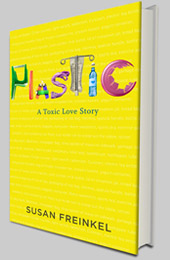Everyday I receive a news alert from the American Chemistry Council and each day it seems the alert contains at least one or more entries about fracking — the controversial practice of extracting natural gas (or oil) from shale. Even as recently as a few months ago, fracking was scarcely mentioned. Now, the ACC dispatches are brimming with excitement over the prospect of vast new supplies of low-cost natural gas, such as this article in Bloomberg News which was headlined, “Cheap Shale Gas Means Record U.S. Chemical Growth.”
What a difference a few hydraulic drills can make. When I was interviewing people in the plastics industry two to three years ago, there was a pervasive sense of impending doom. Oil and natural gas prices were high, pushing the petrochemical companies that make raw plastics to relocate closer to regions rich in the fossil fuels that supply the industry’s raw materials. Experts believed that the plastic industry’s center of gravity was shifting from its historic roots in North America and Europe to the Middle East and Asia. Now there’s this sense of jubilation — American plastics is roaring back to life! — fueled by faith in fracking. And indeed, thanks to new — and environmentally dangerous — drilling methods, expanding shale operations from Texas to Pennsylvania have dramatically dropped the price of natural gas, which provides the feedstock for about 70 percent of the plastics produced in this country, most notably polyethylene. (Elsewhere in the world, oil is the main starting ingredient for plastic.) The Energy Information Administration predicts shale gas could account for as much as 47 percent of American gas production by 2035, up from 16 percent in 2009.
Several of the major petrochemical companies have announced plans to build new crackers — the gigantic $1.5 billion furnaces that break up hydrocarbons into the gases such as ethylene or benzene that are used to make plastics and commodity chemicals. No new crackers have been built in the U.S. since 2001. But in recent months, Dow, Chevron Phillips, Occidential and Formosa Plastics have all announced plans to build crackers in the Gulf Coast. Shell Oil says it will construct a cracker to produce ethylene in Appalachia, site of the massive Marcellus Shale formation; it’s the first to be built in the region in over 50 years. Eastman is reopening one of its crackers, while LyondellBasell plans to invest in another.
No one, however, is on a bigger building binge than Dow, the world’s largest producer of polyethylene. Just a few years ago Dow was closing down and/or shrinking its U.S. plastics facilities and trying to move operations to Kuwait and Saudi Arabia. Now Dow plans to spend about $4 billion to build a new cracker near the Gulf Coast, reopen another in Louisiana and construct two plants devoted to propylene, the base ingredient for polypropylene. “The U.S. now has investment-grade economics, and because of shale we are going to lock those economics in,” Dow CEO Andrew Liveris told Bloomberg News.
All this investment in ethylene crackers means stepped up production of polyethylene, as well as other commodity plastics. It will be interesting to see what happens then. One of the main uses of polyethylene is in packaging — the very sector of the plastic economy under sharpest political attack at present. Will the industry push back harder against efforts to reduce excess packaging and measures to ban polyethylene bags? Will there be even less incentive for the industry to get behind recycling measures — since the price of virgin polyethylene is bound to drop? Will the flood of shale-gas reduce incentives to develop renewable feedstocks for plastics? Will we see new polyethylene applications, or an increased drive to export to new markets overseas?
My concern is that many of our plastic problems trace back to the fact that it is all too easy to waste — too much is used for single-use packaging and throwaway products; there are too few economic incentives to recycle or reuse, much less reduce our reliance on new plastic stuff. We’re currently consuming 300 pounds of plastic a year — ten times the amount used in 1960. My fear is vast supplies of cheap new plastic ensure that number will only go up. It will be that much harder to drive home the message that the low price of plastic (or by extension, natural gas) doesn’t reflect its true cost, and that while we may seem to have endless supplies of this fantastically cheap material, it is still worth way too much to waste.




Hi, Susan – Plastics made out of oil can be made to biodegrade in landfills, where it will contribute to methane harvesting. This is far more advanced than most people realize. The landfill methane production saves enough fuel from non-renewable resources to power 14 million cars a year! See http://earthnurture.com for an additive that does just that.